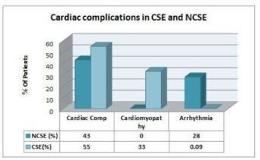CARDIAC COMPLICATIONS IN CONVULSIVE AND NONCONVULSIVE STATUS EPILEPTICUS
Abstract number :
2.426
Submission category :
Year :
2014
Submission ID :
1868978
Source :
www.aesnet.org
Presentation date :
12/6/2014 12:00:00 AM
Published date :
Dec 4, 2014, 06:00 AM
Authors :
Kanika Arora, Yara Nazzal, Mohammad Haider, A K Arifuzzman, Sandipan Pati and M. Brandon Westover
Rationale: Cardiac complications in status epilepticus(SE), especially in convulsive SE(CSE) are well known. Our goal was to assess the patterns of cardiac complications in non-convulsive SE(NCSE) and compare them with CSE. We hypothesized that cardiac complications in NCSE differ in type and frequency from CSE. Methods: A single centre, retrospective study involving 47 consecutive patients (adults and children) admitted in the neuroscience intensive care unit following diagnosis of CSE and NCSE. Cardiac complications were assessed byEKG, echocardiogram, and troponin values. Results: 70% (N=33) had CSE and the remaining 30%(N=14)had NCSE.The most common etiology of SE was intracranial bleed (42%). Average length of stay in the ICU was 9.7 days. Cardiac complications were seen in 43% (N=6) of NCSE and 55% (N=18) of CSE patients. Cardiac complications included: cardiomyopathy or left ventricle hypokinesia, elevated troponins, and EKG abnormalities.Cardiomyopathy was predominantly seen in CSE (33%) VS 0% in NCSE while malignant arrhythmias were commonly seen in NCSE (28%) VS 0.09% in CSE . Conclusions: The frequency of cardiac complications in NCSE was similar to CSE. However patterns of cardiac complications in NCSE were clearly different from CSE.These findings suggest that the underlying mechanisms and optimal methods of monitoring to detect and prevent adverse cardiac outcomes may be different for CSE and NCSE. These preliminary findings should be confirmed in a larger cohort.
